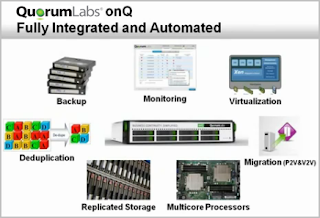PTS Data Center Solutions has launched a strategic distribution relationship with Compellent Technologies and ExaGrid Systems. The relationship includes the full breadth of products from both manufacturers targeted for midsized enterprises.
As a data center consulting and turn-key solutions provider, PTS provides integrated data center facility and IT technical expertise for clients. With a proven process for understanding and addressing client needs, as well as integrated facilities and IT experience & expertise, PTS has a unique vantage point for executing data center, computer room, and network operations center projects. PTS understands the impact IT architecture and network design approaches have on the underlying facility layer in terms of power, cooling, and space considerations and seeks out best-of-breed IT solutions that reduce facility load requirements.
"PTS is often approached by clients requesting support to improve data center efficiencies through energy efficiency analysis, computational fluid dynamic modeling, and virtualization assessments. By expanding our portfolio of storage, backup, and data deduplication solutions with two leading providers in Compellent and ExaGrid Systems, we are providing leading edge solutions with proven track records. Compellent's block-level storage management offers a more granular approach to automatically and actively manage data resulting in reduced data center costs, footprint, and energy consumption. ExaGrid System's scalable disk-based backup solutions reduce the total amount of disk space needed through backup compression and deduplication. Together with PTS' consulting services, we are able to significantly reduce overall data center operational expenses," said PTS President, Peter Sacco.
Compellent's Fluid Data architecture enables superior utilization and efficiency while its unified storage with zNAS offers a single user interface to streamline management of heterogeneous Unix, Linux and Windows file and block data. The Fluid Data architecture increases storage efficiency and utilization by automatically tiering file storage at the block-level, intelligently thin provisioning storage for unstructured data, and delivering rapid data recovery and thin replication. Integrated SAN and NAS management simplifies planning, provisioning and recovery of virtual servers in VMware, Microsoft, Citrix, and Oracle environments.
The ExaGrid Disk-based Backup System is a turnkey, plug-and-play solution that works with existing backup applications and enables faster and more reliable backups and restores. Customers report that backup time is reduced by 30 to 90 percent over traditional tape backup. ExaGrid's patented byte-level data deduplication technology and most recent backup compression, coupled with high-quality SATA storage, reduces the amount of disk space needed by a range of 10:1 to as high as 50:1, or more, resulting in a price that's often less than traditional tape-based backup.
About PTS Data Center Solutions
Experts for Your Always Available Data CenterPTS Data Center Solutions specializes in the business strategy, planning, designing, engineering, constructing, commissioning, implementing, maintaining, and managing of data center and computer room environments from both the facility and IT perspectives.
Founded in 1998, PTS is a consulting, design/engineering, and construction firm providing turnkey solutions, and offering a broad range of data center, computer room, and technical space project experience. PTS employs industry best practices in integrating proven, ‘best-of-breed’, critical infrastructure technologies that result in always available, scalable, redundant, fault-tolerant, manageable, and maintainable mission critical environments.
In every engagement, PTS applies a disciplined, consultative approach to systematically survey and assess the situation and then develop effective plans for seizing opportunities and overcoming obstacles. And, PTS offers a full complement of services—from business strategy and planning to facilities engineering to IT design and implementation—to help transform those plans into reality.
For more information and news, visit the PTS website at
www.PTSdcs.com.
About Compellent Compellent Technologies (NYSE: CML) provides Fluid Data storage that automates the movement and management of data at a granular level, enabling organizations to constantly adapt to change, slash costs and secure information against downtime and disaster. This patented, built-in storage intelligence easily delivers significant efficiency, scalability and flexibility. With an all-channel sales network in 35 countries, Compellent is one of the fastest growing enterprise storage companies in the world.
For more information, visit the Compellent website at
www.compellent.com.
About ExaGrid SystemsExaGrid Systems offers the only disk-based backup appliance with data deduplication purpose-built for backup that leverages a unique architecture optimized for performance, scalability and price. The combination of post-process deduplication, most recent backup cache, and GRID scalability enables IT departments to achieve the shortest backup window and the fastest, most reliable restores, tape copy, and disaster recovery without performance degradation or forklift upgrades as data grows. With offices and distribution worldwide, ExaGrid has more than 2,400 systems installed at 600 customers, and more than 170 published customer success stories.
For more information, visit the ExaGrid website at
www.exagrid.com.
# # #
Contact Information:
Larry Davis
PTS Data Center Solutions
201-337-3833 ext. 123
ldavis@ptsdcs.com
Liem Nguyen
Compellent Technologies
952-294-2851
liem.nguyen@compellent.com
Bill Hobbib
ExaGrid Systems
508-898-2872 ext. 286
bhobbib@exagrid.com



























.jpg)
